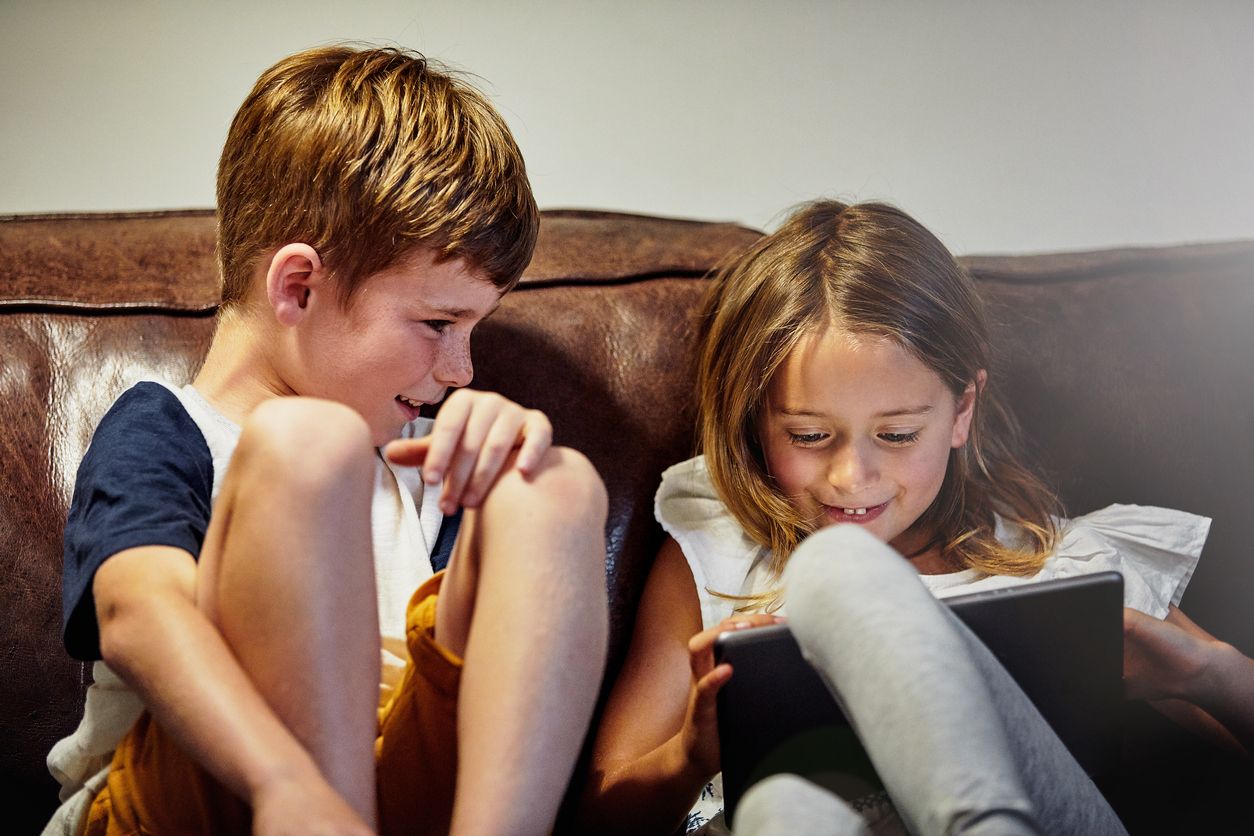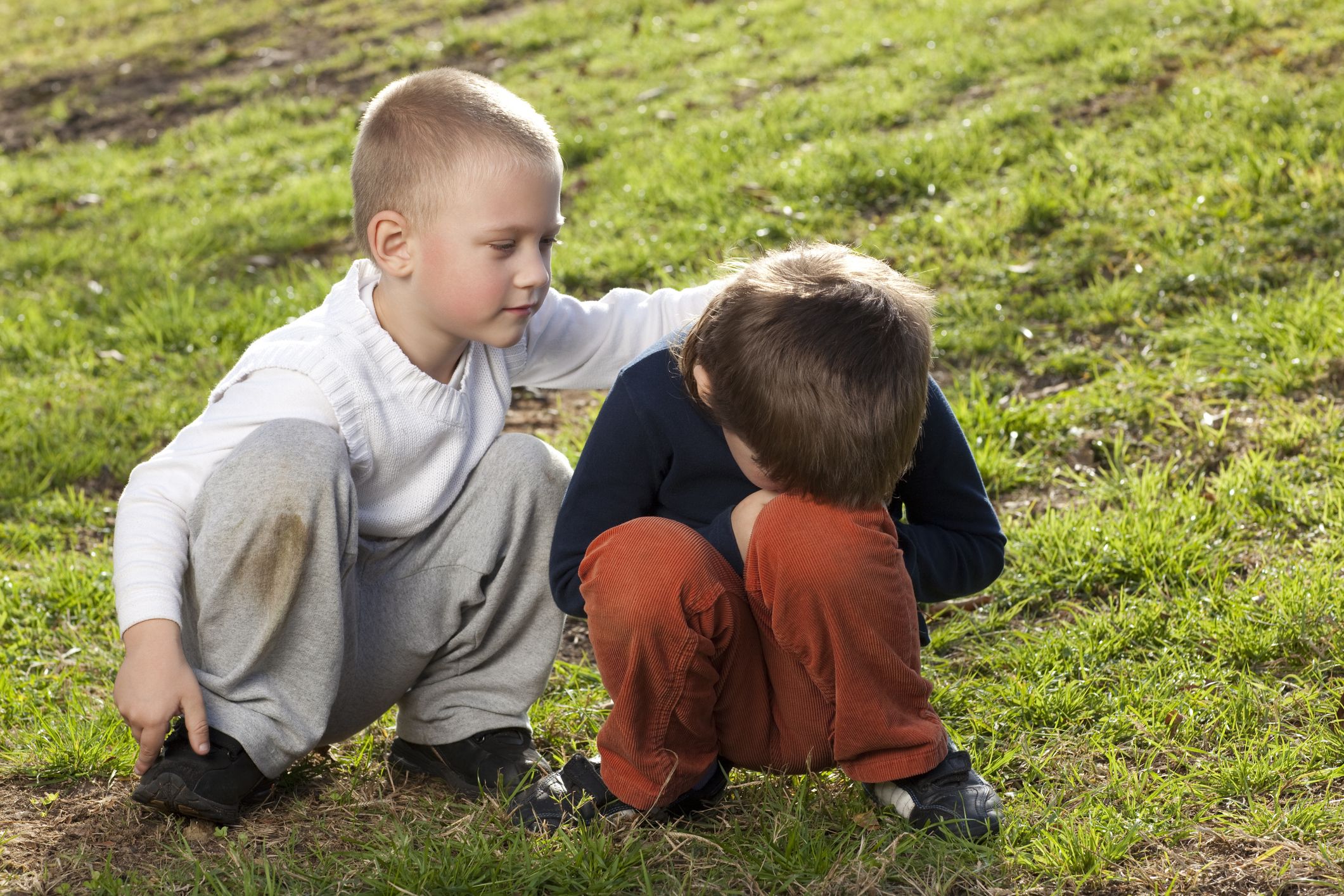A few months back, I went into The Flooring Place to get my Douglas Honeycomb shades repaired. As I waited to speak to a clerk, I saw an ad about flooring that read: Water resistant. Worry relief. This ad illustrated a simple principle: prevention.
Empathy is prevention. Empathy creates relief from emotional duress and upset. When a person truly listens and understands us, we feel heard, and emotions dissipate. Upset is no match for empathy. Feeling heard is a human need, and an empathetic response goes to the core of this need. And it's why empathy is important in parenting and in a child's development. So how do we teach this critical skill to our children?
Estimated reading time: 6 minutes

Emotional Literacy Is the First Step of Teaching Empathy
When a child is developing emotionally, emotional literacy is the first building block of constructing morality and empathy. Let’s look at what emotional literacy means and why a child must first be able to identify their emotions before understanding them and showing compassion for others.
Mary Gordon, the author of Roots of Empathy, states the importance of emotional literacy succinctly:
"Emotional literacy is described as the ability to recognize, understand, cope with, and express our emotions in appropriate ways. When we add empathy to this mix and put it in the social contexts within which we all live, we have the basis for morally responsible behavior."
To learn how to identify, modulate, and express their emotions is a hefty order in and of itself. Alongside this ability, our children also need to be equipped to effectively handle their inner conflicts and the social challenges they will face without harming themselves or others. Just like the flooring ad purports: prevention is fundamental to being worry-free.
Emotions Are Universal and Need to Be Felt!
Emotions often get a bad rap—especially if they are expressed inappropriately by children. For example, you’re at the grocery checkout line, and your preschooler has a fit because you say no to a request for a candy bar. Or you ask your teen to get off their X-box, and they talk back and get angry. Or you observe your child hesitant to share and you take the toy and hand it to their friend and say, “We share in this family.”
Parents want their kids to have emotional maturity; however, often without even realizing it, they react negatively to a child's emotions. They unintentionally make them wrong for what they're feeling or block them from feeling altogether. Mary Gordon continues:
“Every time we don’t see or hear or respond to a child’s emotional expression, we are depriving that child of emotional oxygen. By the time most of us are adults, we are not willing to admit to fear, even to ourselves. We will make ourselves ill rather than become vulnerable emotionally by acknowledging feelings that we define as weak.”
Parenting can definitely be stressful, so reactions are understandable. However, whenever we shut down a feeling (our own or another’s), the emotion doesn’t get felt. We are all way too familiar with the alternatives: stuffing, repressing, ignoring, suppressing, dumping, denying, etc. Whenever we attempt to stop our children from feeling, these reactions are called feeling stoppers.
Some typical feeling stoppers are denying, shaming, fixing, minimizing, and blocking. Here are examples of each:
“You don't hate your sister!” → denying
“Shame on you for yelling at your brother!” → shaming
“Feeling blue? Why don't you go next door and see if Susie can play.” → fixing
“You're making too big of a deal about losing; it’s just a game.” → minimizing
“Stop feeling sorry for yourself. Think about something else.” → blocking
Parents tend to use feeling stoppers because they're stressed. Sometimes we want to stop the feeling because as a parent, we're too full of emotions ourselves, or a child's feelings are inconvenient when there are a million things to get done. Or other times, their emotions can trigger a parent’s unresolved emotions and past hurt.
Feelings need to be felt.
Feelings are not right or wrong, good or bad; they just are. And like it or not, we can’t prevent or stop ourselves or our children from feeling.
Each emotion we experience has a purpose. Sadness tells us of a loss; envy or jealousy shows us what we desire or areas we need to develop; joy communicates our fulfillment; anger warns us of a violated boundary or a deep hurt.
All emotions are important to feel. Therefore, none of our child's feelings are wrong or bad nor unworthy of our attention. The building of emotional intelligence depends on feeling fully and taking action to return to our True North. It’s a parent's job to help a child navigate this process.
Related reading: "Parenting Your Teenager with Emotional Intelligence."
 Now, let’s dive into the how-to for teaching our children empathy, tolerance, and compassion.
Now, let’s dive into the how-to for teaching our children empathy, tolerance, and compassion.
How to Teach a Child Empathy
No one can empathize with another person’s feelings without first being able to identify and feel them. Here are some ways to help children and teens identify and understand their emotions through emotional literacy, beginning with infants:
NAME the child’s emotions.
When children are very young, they need their parents to help identify their emotions regularly. You’re feeling sad, hurt, angry, happy, etc. As they get older, don’t tell, ask: “Are you feeling frustrated?” or “You look frustrated, are you?” As soon as a feeling is named, it relieves the tension and assists in self-regulation.
This identification process lessens the intensity of the emotion. Simple labeling is key to helping children identify what they’re feeling so they can calm themselves effectively. And it is one of the first steps in teaching them empathy.
IDENTIFY your emotions and family members in real-time interactions with your children.
“Mommy is frustrated because the vacuum cleaner is clogged.” “I’m sad because I had to work and miss your play.” “Grandma was so happy to see you at Christmas; look at her beaming smile in these pictures!”
To learn how to replace feeling stoppers with feeling encouragers, release judgment, and practice the skill of empathy as a parent, try our downloadable workbook. You'll be glad you did!
Related reading: "How to Talk to Someone with Empathy—and What to Avoid!"
 MIRROR children's emotions.
MIRROR children's emotions.
It’s equally important for parents (and grandparents) to accurately mirror a child's feelings—no matter how young a child is or what he or she is experiencing. If an infant is upset because they’re hungry or don’t want their diaper changed, mirroring that upset helps to show them that their feelings matter. When a young child is upset about a friend grabbing a toy, a parent can reflect that upset as well. Or if a teen is excited and celebrating a big win at school or in sports, show your shared enjoyment. If they’re distressed about losing a game, don’t tell them to “Get over it!” or “It’s just a game!” Show them that you care and understand from their perspective how it feels. This ability is the essence of empathy.
Related reading: "How to Teach Your Kids to Care About Other People"
ASK children what another person might be feeling.
After helping a child identify their feelings, the next step in learning empathy is cultivating an emotional intelligence skill commonly called social awareness. Whether in public places such as a park or shopping mall, we can build greater awareness by asking them to observe and identify facial expressions and emotional body language with strangers from a distance. In this way, there’s no risk or consequence of making a mistake.
The more they practice, the better they will hone into the cues that emotions give. As children practice spotting emotions in others in nonthreatening ways, it also reinforces and helps them anchor understanding around their own emotions. Seeing a feeling in another person can assist them in discovering times when they felt that same emotion but may not have previously recognized it.
- With very young children, keep it simple. Make observations or ask obvious, easy questions giving only two opposite emotions to choose from: happy/sad; glad/mad; surprised/excited, etc.
⇒ Aww...that little girl skinned her knee on the climber; she must be feeling sad. Or “Is that little girl feeling happy or sad?”
⇒ Three neighbor boys are laughing and playing in the sprinkler. “What fun! They are so excited.” Or “Are those boys happy or sad? Joyful or angry?”
⇒ A baby is crying in a cart at a Target checkout line. “Oh, that baby is sad, isn't she?’ Or “Is the baby in the cart happy or sad?” - For older children (or as they get more skilled at feeling identification) ask more open-ended questions with more detail.
⇒ Walking on a city street: “What do you think that man might be feeling while talking on his phone?” (Cues: wrinkled forehead, stern eyes, pursed mouth, and head down.)
⇒ On a televised game: “What did the players and coach feel when their team lost the basketball game?” “Did you notice that each player handled the loss differently?” “And how did the winners respond to the losing players?”
⇒ In school: “What did your teacher likely feel when the children were not paying attention and talking out of turn?” “What did the child feel when he was chastised?”
⇒ In the park: “What do you think that child felt when his brother beat him in the race to the swing?”
⇒ At the grocery store or mall: “What might the clerk have felt when their manager snapped at them for being late?”
For a wonderful resource on the different kinds of emotions, check out the Wheel of Emotions by Robert Plutchik.
 Help children and teens to understand others’ perspectives, but FIRST, make sure they feel understood.
Help children and teens to understand others’ perspectives, but FIRST, make sure they feel understood.
To teach and model empathy, it is a MUST to empathize with your child FIRST before trying to get them to see someone else’s perspective. One mistake many parents make is trying to get their child to understand the other person’s feelings while he or she is in the midst of their own emotional experience.
It’s a temptation to say things like, “Think how Suzy feels,” or “Tommy must have had a good reason for getting mad at you.” or “Your dad probably didn’t mean it. He’s just having a bad day!”
However, children and teenagers must first feel understood and heard BEFORE they are ready to seek to understand another’s experience. We invalidate a child’s feelings when we try to get them to understand someone else too quickly. First, allow them to feel whatever they’re feeling. Watch for their emotions to subside. Once they feel heard, most children will shift and get curious on their own.
Related reading: "How to Build Healthy Emotional Development in Children."

It's never too young to show empathy!
There’s a misconception that young children are incapable of empathy even though very young children do some of the most empathetic acts.
Once while doing childcare at a summer camp, I witnessed a 4-year-old boy interacting with an infant. He picked up the infant by the arms into a sitting position. Then just as he got the baby upright, she fell back to the ground. Of course, several adults quickly rushed to the baby’s rescue. Thinking that he was acting with malice, the adults moved to chastise him. However, when I inquired what he was trying to achieve, I’ll never forget his answer. He replied, “I was trying to lift her so she could see the rainbow, but she was too heavy for me and slipped through my hands.”
Model empathy and emotional intelligence (EQ) for your children.
One of the most powerful ways to teach children empathy and EQ is through modeling as a parent. Responding instead of giving knee-jerk reactions; seeking to understand your children’s feelings; expressing your emotions appropriately; taking time to self-calm when tough emotions arise. Each time you provide a model worth following, it helps children have a potent mirror to see themselves and an example to emulate.
Don't make the mistake of moving too quickly to explain or problem-solve or get a child to empathize with others. It’s vital that we first slow down and MODEL, MODEL, MODEL! Modeling is the most effective way to impart any skill or virtue.
Related reading: "The Three Kinds of Empathy: Cognitive, Emotional, and Empathy."
Empathy is born first within us before it is a gift to our children.
If you'd like to master empathy so you can model more effectively for your children, check out our downloadable workbook, "Real Empathy, Real Solutions."
For expert parenting advice or tips to bring more ease to your parenting, sign up for our newsletter!








